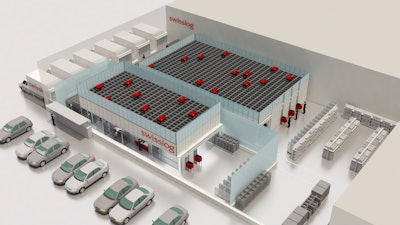
*This article brought to you by Swisslog.*
To say the early days of the pandemic were chaotic for most grocers is probably an understatement. Supply chain shortages, the need for new safety protocols and the surge in online orders all stretched resources and processes close to the breaking point.
That was when the concept of automating e-grocery fulfillment close to customers through micro fulfillment centers (MFCs) and e-grocery fulfillment centers (EFCs) first began to gain traction. Using goods-to-person automation technologies, MFCs offered grocers a way to efficiently manage and scale e-grocery services while reducing dependence on a shrinking labor pool.
Newer automation systems were even compact enough to promise grocers with larger stores the ability to embed automation within the store. Instead of having order fillers pushing oversized carts up and down aisles and alienating in-store shoppers, grocers could turn their back rooms into automated fulfillment centers capable of manage growing order volumes faster and at lower cost.
That was an attractive proposition for grocers struggling to keep pace with a rapidly evolving market and there was plenty of interest across the industry. A number of grocers made plans to stand up MFCs as quickly as possible.
Most of those plans ended up stalling as grocers faced the complexity inherent in automating fulfillment close to customers and the lack of clarity around key decisions they would face as they moved forward. There were competing business models, distribution strategies and automation technologies to consider and no real-world experience to use in navigating those decisions.
That lack of experience also translated into uncertainty around the ROI they could expect. How much of a typical order could be filled through automation and how fast? Could they trust the throughput projections automation providers made if their systems had never actually dealt with the complexity of a typical grocery order? What if e-grocery volumes returned to pre-pandemic levels when the economy opened up?
There were just too many open questions and too much uncertainty to develop a solid business case for MFC automation and many grocers put their plans for automation on hold.
Gaining real-world experience
There were, however, some grocers who forged ahead amid this uncertainty. There were some failures and disappointments when e-grocery proved even more complex than it first appeared. But there were also successes, and those successes are now lighting the way for the next wave of grocers moving forward with their e-fulfillment strategies.
The grocers who have experienced success with automated fulfillment have taken different approaches in their distribution strategies—some choosing MFCs serving one or a group of stores and others deploying larger distribution hubs—but there are many common characteristics that distinguish those who succeeded with automation from those whose projects failed to meet expectations.
One of those characteristics is the automation technology selected. While both shuttle systems and AutoStore have been promoted as solutions for e-grocery fulfillment, AutoStore has now proven to be the superior solution for this application. E-grocery automation needs to provide high storage density, sustained throughput, application flexibility, and the reliability to enable continuous operation. AutoStore delivers on all fronts.
AutoStore empowered by Swisslog is a robot-based automated storage and retrieval system that has low maintenance requirements and maintains access to all inventory if a robot has to be taken offline for service. Unlike with shuttle systems, each robot can reach any bin in the system so even during service orders keep flowing. Fast-moving products naturally migrate to the top of the grid and advanced slotting strategies can be employed to enable fast bin presentation speeds. The system’s unique cube design, in which storage bins are stacked vertically up to six meters high, provides the highest storage density in most MFC and EFC environments and the system can be configured to adapt to irregular spaces in buildings and to work around obstructions such as support pillars.
The experience of successful early adopters has also highlighted the importance of the software that controls the AutoStore system. E-grocery applications not only require that the software be able to orchestrate manual and automated picking but also to manage inventory based on factors that aren’t relevant in other e-commerce applications, such as expiry and best-by dates. The ability to store partially completed orders in the automation system has also proved valuable in managing fluctuating demand and has the ability to organize consolidation based on pickup and delivery schedules.
One other characteristic that grocers who have had success with automated fulfillment have in common: they worked with an integrator with extensive AutoStore experience, software tailored to the requirements of e-grocery fulfillment, and the ability to take a data-driven approach to solution design that helps clarify distribution strategies and supports the development of a solid business case.
New resources for grocers
As the e-grocery fulfillment partner with the most experience implementing successful MFCs and EFCs, Swisslog has captured our knowledge and experience working with early adopters in a new e-book, The E-Grocery Evolution: Moving Automated Fulfillment from Strategy to Execution.
This resource is designed to help grocers navigate key decisions based on the experience of grocers who have implemented successful MFCs and EFCs. We believe it's a must-read for every grocer evaluating the feasibility of e-grocery automation or moving forward with MFC and EFC strategies.
Swisslog is also hosting a webinar on e-grocery automation: Forget Everything You Think You Know about MFCs. The April 21 session is open for registration.
E-grocery automation is in a much different place today than it was two years ago when grocers were looking for real-world experience on which to base decisions and couldn’t find it. While e-grocery automation is still a complex undertaking, we now have the knowledge and experience to navigate this complexity. If you need help refining your strategy or evaluating your automation options, contact us.
*This article brought to you by Swisslog.*

















![Pros To Know 2026 [color]](https://img.sdcexec.com/mindful/acbm/workspaces/default/uploads/2025/08/prostoknow-2026-color.mduFvhpgMk.png?ar=16%3A9&auto=format%2Ccompress&bg=fff&fill-color=fff&fit=fill&h=135&q=70&w=240)

